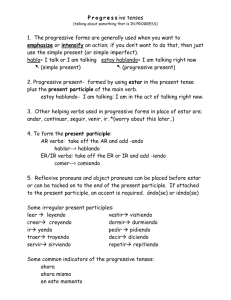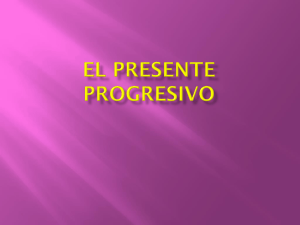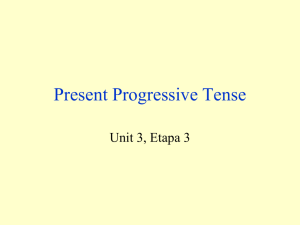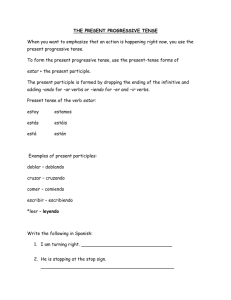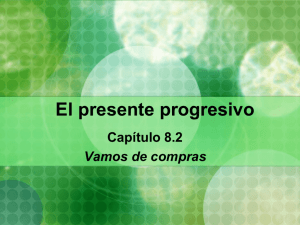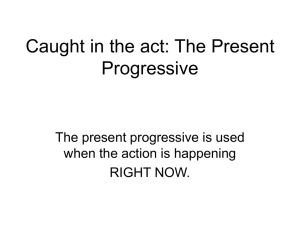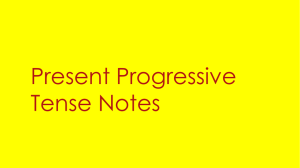Present Progressive Tense Unit 3, Etapa 3
advertisement
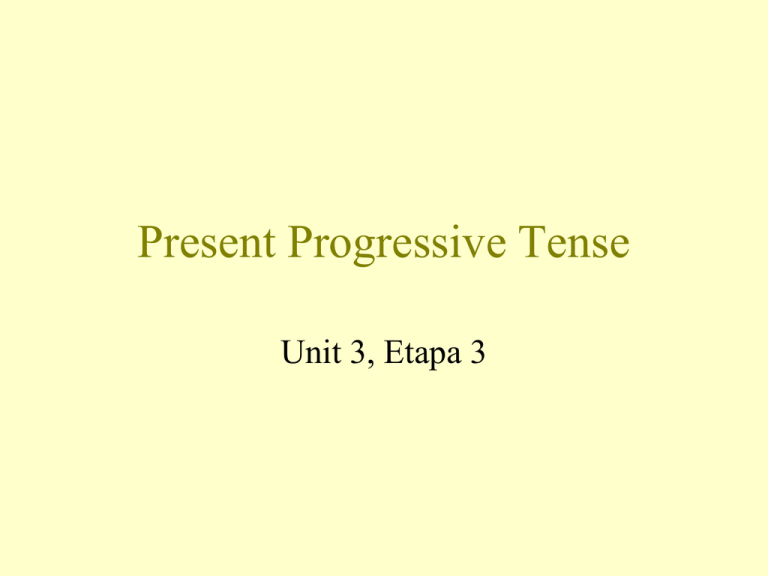
Present Progressive Tense Unit 3, Etapa 3 Present Progressive –ar Verbs -ar Verbs • Explanation of Present Progressive in English • Explanation of Present Progressive in Spanish & Review of Estar • Forming the Present Participle • Practice with the Present Progressive of –ar verbs • Translations with Present Progressive of –ar verbs -er & -ir Verbs • Explanation of Present Progressive in English • Explanation of Present Progressive in Spanish & Review of Estar • Forming the Present Participle • Practice with the Present Progressive of –er verbs • Translations with Present Progressive of –er verbs -yendo verbs • Explanation of Present Progressive with -yendo • Practice with Present Progressive with –yendo • Translations with Present Progressive -yendo Present Progressive in English The present progressive is used to say that an action is happening now. In English, we use 1. the present tense of “to be” plus 2. the present participle which ends in -ing. I am reading. Present Progressive in Spanish & Review of Estar In Spanish, we use the present tense of “estar” as the helping verb. to be estar = ___________ Estoy = I am Estamos = We are Estás = You are Está = He is She is You are Están = They are You all are Forming the Present Participle of –ar verbs To form the present participle: 1. drop the ending of the infinitive: bailar 2. add the following: bail -ando Bailando - Dancing Practice with Present Progressive –ar verbs bailar = to dance bailando = dancing Él está bailando. (He is dancing.) nadar = to swim nadando = swimming Ellos están nadando. (They are swimming.) trabajar = to work trabajando = working Los estudiantes y yo estámos trabajando. buscar to look for Mi compañera está buscando su tarea. esperar to wait for, to expect Mi amigo y yo te estamos esperando. usar to use Las chicas están usando las computadoras. descansar to rest Mis padres están descansando. Estudiar = _________ to study Present Partciple (-ing): estudi ando Say the following and remember to use: present tense of “estar” plus the present participle I am studying. Yo estoy estudiando. You are resting. Tú She is talking. estás descansando . Ella está hablando. We are waiting. Nosotros They are helping. estamos esperando. Ellas están ayudando. Present Progressive in English The present progressive is used to say that an action is happening now. In English, we use: present tense of “to be” plus the present participle which ends in -ing. I am reading. Present Progressive in Spanish & Review of Estar In Spanish, we use the present tense of “estar” plus the present participle. to be estar= ___________ estoy estamos estás está están Forming the Present Participle of –er & -ir verbs To form the present participle: 1. drop the ending of the infinitive: comer com 2. add the following: -iendo comiendo Practice with Present Progressive -er verbs llover to rain Afuera está lloviendo. comer to eat Josefina está comiendo. correr to run Los muchachos están corriendo. escribir to write Nosotros estamos escribiendo. hacer to do El niño está haciendo la tarea. Ver to see Juan y Juanita están viendo la televisión. Present Progressive using -yendo ¡OJO! (Watch out!) When the stem of an -er/ir verb ends in a vowel, use yendo. To form the present participle: 1. drop the ending of the infinitive: leer le 2. add the following: -yendo Leyendo = reading index oír to hear oyendo index creer to believe, to think creyendo index leer to read leyendo index Marcos is reading the newspaper. Marcos está leyendo el periodico. index I am hearing the birds. Yo estoy oyendo a los pajaros. index ¡Tú estás terminado!
